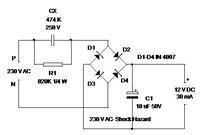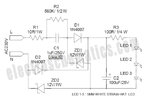DasPreetam
Advanced Member level 4
I'm seeing these new LED bulbs that last much longer and save huge amount of power than ordinary light bulbs... The idea seemed pretty basic to me... You hook up leds to a power supply, they glow. But they are pretty expensive, so I looked up a few DIY circuits on the net
Almost all of them was using a transformerless power supply consisting of a capacitor... My question is, is this really necessary ? Can't we just use a high resistance before the rectifier in order to get the job done ?
Almost all of them was using a transformerless power supply consisting of a capacitor... My question is, is this really necessary ? Can't we just use a high resistance before the rectifier in order to get the job done ?

